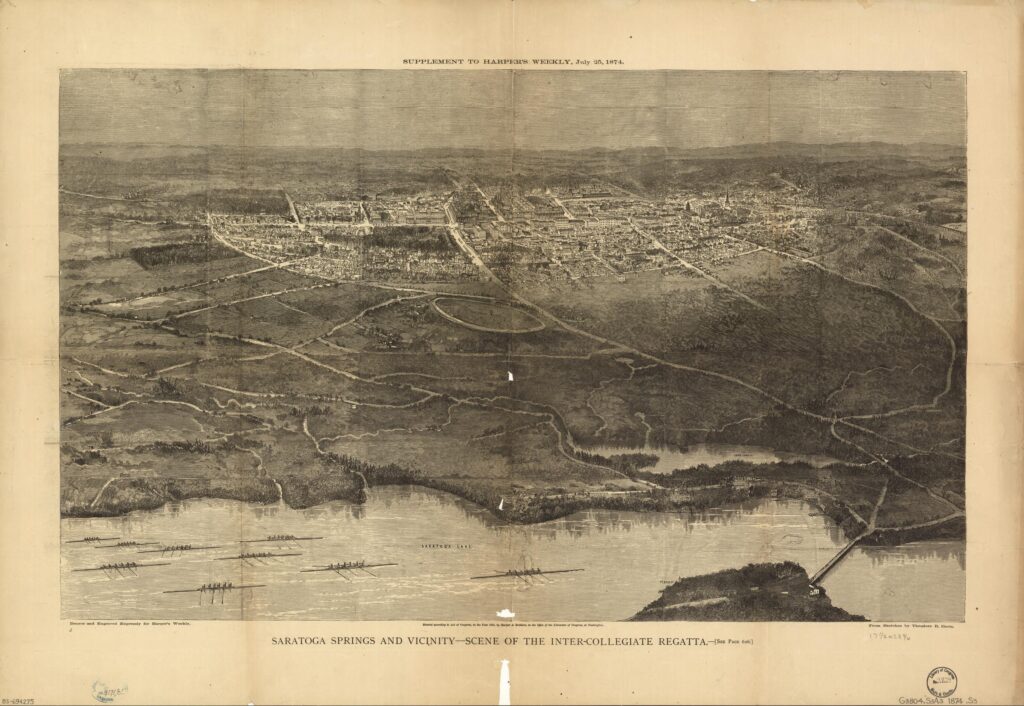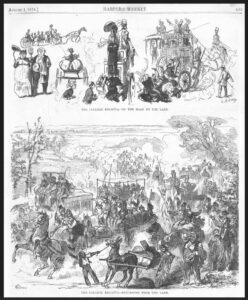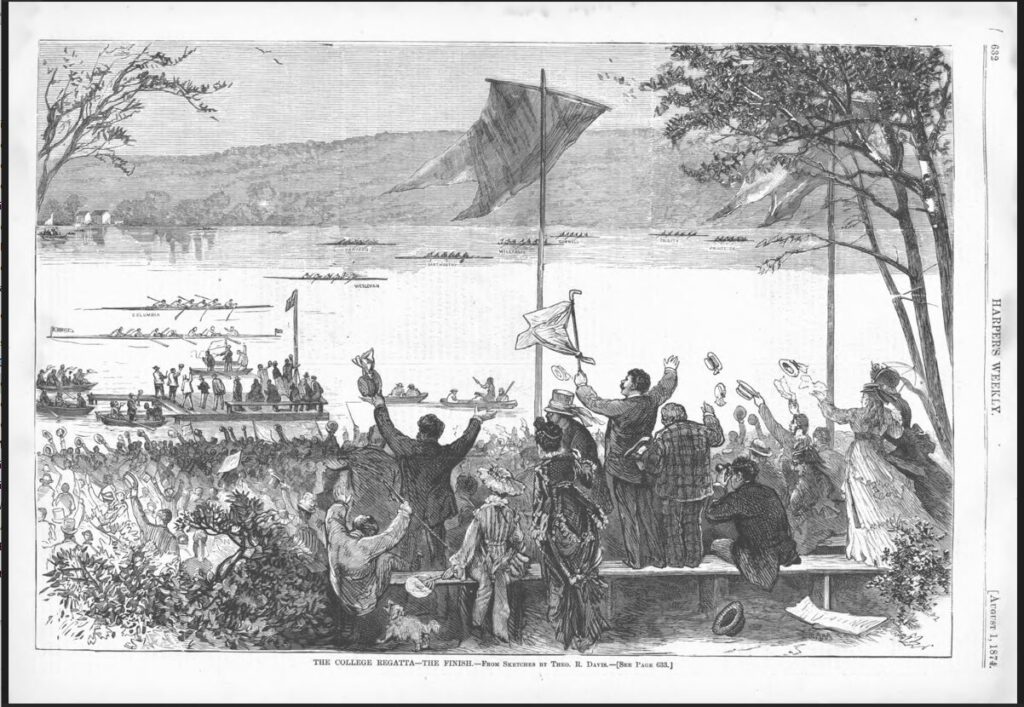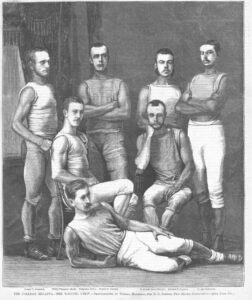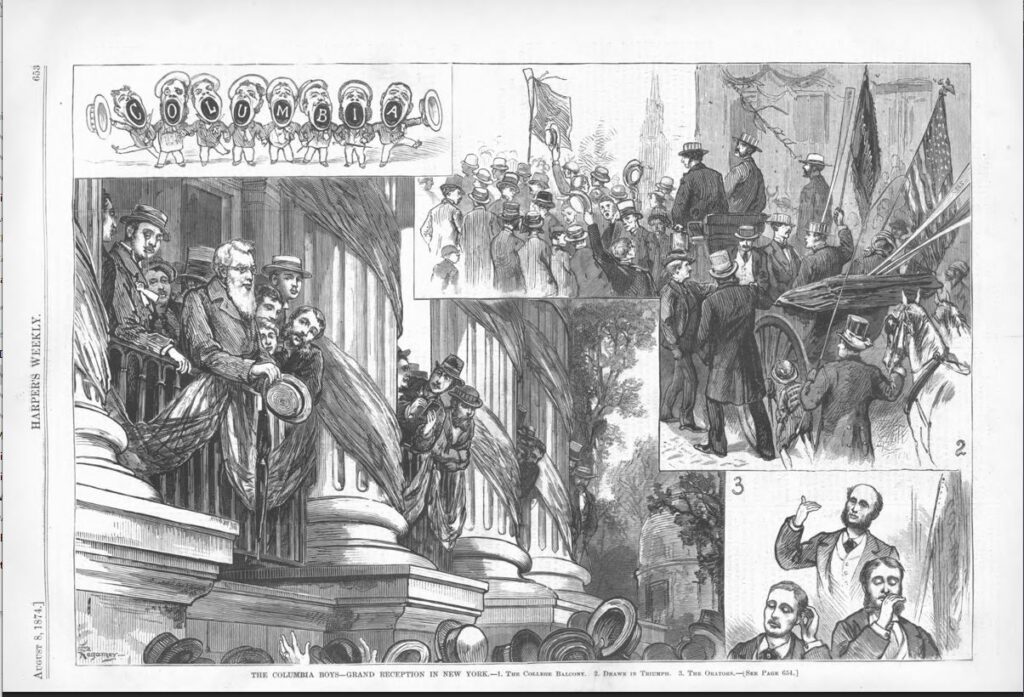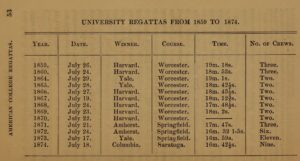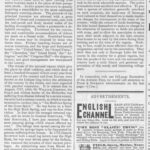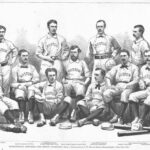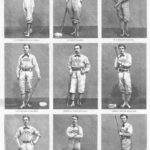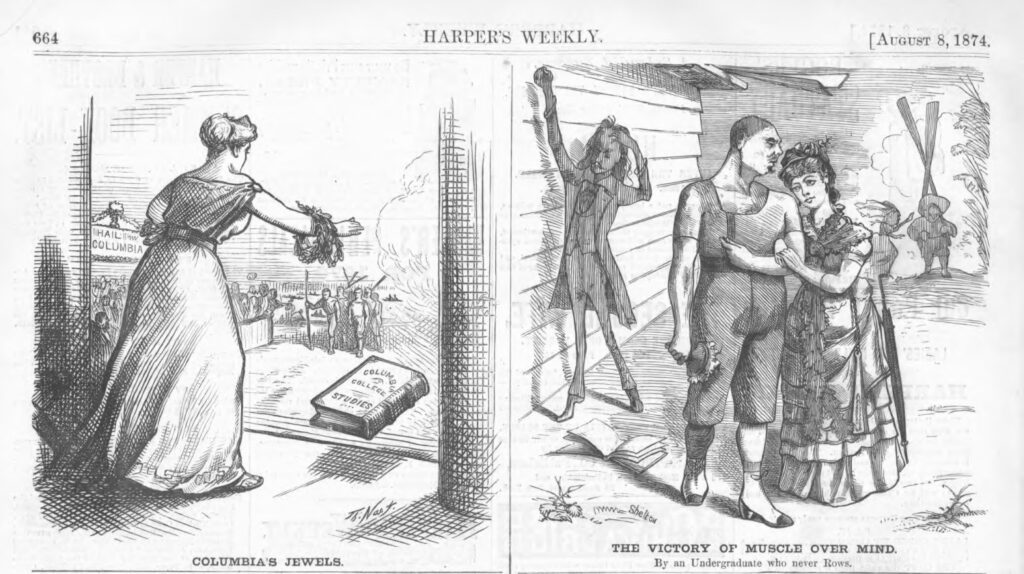Columbia College was in the news 150 years ago this summer as its varsity rowing team won its race at an intercollegiate regatta on Saratoga Lake in New York state. The race had to be postponed twice because of choppy waters, but third time was a charm – at least the race was successfully completed, but, as Harper’s Weekly explained in its August 1, 1874 issue, the number of spectators was much smaller for the third try:
THE COLLEGE REGATTA.
THE pleasure of the Inter-collegiate Regatta this year was marred by two disappointments, one of which might have been prevented by proper management on the part of the committee. The afternoon of July 16 was the time chosen for the grand race, and long before the hour appointed for the start the shores of the lake were thronged by thousands of enthusiastic spectators, who waited impatiently for the boom of the signal-gun. Every vehicle in Saratoga and the surrounding country was pressed into service, and the hack-men and farmers made the most of their opportunity. But as the hour named for the start drew near the wind became fresh, and so roughened the surface of the lake that it was considered imprudent for the light shells to venture out. After waiting until long beyond the starting hour, the race was reluctantly postponed until the following day. The committee made the mistake of fixing upon the same hour in the afternoon, instead of choosing an hour in the forenoon, when the lake is almost always as smooth as glass. The consequence was another postponement, on account of rough weather, until darkness put an end to all possibility of a race. Warned by two failures, the committee fixed upon ten o’clock Saturday morning as the hour for starting.
In consequence of these two postponements, there was very little interest manifested in the race on Saturday; and although the day was fair, and the lake smooth as a mirror, there were not more than fifteen thousand people present to witness the contest, and the shores of the lake wore a comparatively deserted appearance. A fair start was made at forty-six minutes after ten o’clock, all the boats getting off in good form; and after a most gallant and exciting race, Columbia came in the winner in 16 minutes 42 seconds. Close behind came the Wesleyans, in 16.50; the other boats in the order indicated in the map on the next page. There was an unfortunate collision between the Yale and the Harvard boats, in which the former lost her rudder and broke an oar. It is yet undecided where the blame lies; but the bitter feeling manifested by both crews can not be too strongly regretted. By this accident Yale was thrown out of the race. The excitement of the crowd as the winning boat crossed the line was indescribable.
The whole concourse of spectators rose on tiptoe, and cheer upon cheer went up, while the fellow-collegians and the backers of the winning crew manifested their delight by flinging up their hats, waving handkerchiefs, and cheering. The names of the winning crew are as follows:
Stroke. — B.F. REES, New York city; age, 20; height, 5 feet 8½ inches; weight, 153 pounds.
2. R.C. CORNELL, New York; age, 21; height, 5 feet 9 inches; weight, 171 pounds.
3. EDWARD S. RAPALLO, New York; age, 21; height, 6 feet; weight, 158 pounds.
4. G. GRISWOLD, New York; age, 18; height, 6 feet; weight, 158 pounds.
5. J.T. GOODWIN, New York; age, 24; height, 5 feet 11 inches; weight, 157 pounds.
Bow. — P. TIMPSON, New York; age, 22; height, 5 feet 11½ inches; weight, 158 pounds.
Averages. — Of weight, 159 pounds; of height, 5 feet 10⅔ inches; of age, 21.
Columbia’s boat is newly built, by FEARON; 49½ feet long, 21 inches wide; weighs 145 pounds. The racing dress consists of blue tights and white handkerchiefs. …
[ On July 15th Princeton beat Yale and Brown in the freshman race, and then Ansley Wilcox from Yale won the single sculls race against one Cornell oarsman and one from Harvard.]
In its August 8, 1874 issue Harper’s Weekly reported on a big celebration greeting the victors on their return to New York City:
THE COLUMBIA. BOYS.
The Columbia boys met with an enthusiastic reception at the railway dépôt on their return from Saratoga. Crowds of eager Columbians and sympathetic friends were gathered to bid them welcome. The favorite colors, blue and white, were worn by two-thirds of the people present. When the train steamed into the dépôt the cheers of the students and their friends pealed forth in ringing tones, and the college cry, C-O-L-U-M-B-I-A, came in at the close with resonant emphasis. After the first hearty greetings and hand-shakings, a procession was formed, headed by a band of music.
The crew carried their oars aloft, each man’s name appearing on the blade of the trusty weapon which he had borne so well in the late struggle. The absent oarsman, Mr. GRISWOLD, who remained at Saratoga, was not forgotten, and his oar, garlanded with the victor blue and white, was carried along with the rest. Outside the dépôt the crew took their seats in President BARNARD’s carriage, which was waiting to receive them. It was their triumphal car, and they themselves were the heroes of the hour. Yet they bore their honors with becoming modesty, even if they were secretly proud of the ovation tendered them. The procession took its way up Forty-second Street amidst the plaudits of the spectators and the answering cheers of the Columbia boys. When near Fifth Avenue the horses were unhitched from the carriage, ropes were attached, and the eager students drew their victorious mates in triumph to the college. From the balcony President BARNARD bade the young victors an earnest welcome. Here the demonstrations were most emphatic. The college was decorated with the Columbia colors, and flags of blue and white were displayed from all the private residences in the vicinity.
After this ceremony the procession re-formed and proceeded to the Windsor Hotel, where a very pleasant reception was held. A social evening closed the triumphant festivities of the day, the various scenes of which are depicted by our artist in the illustration on the preceding page.

